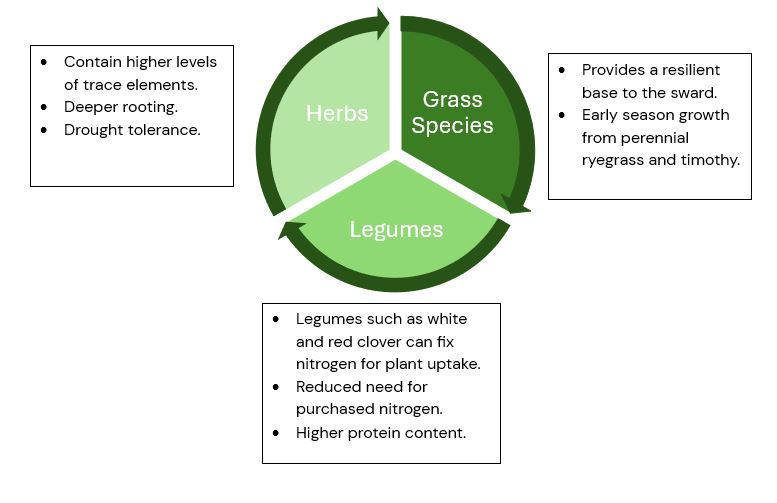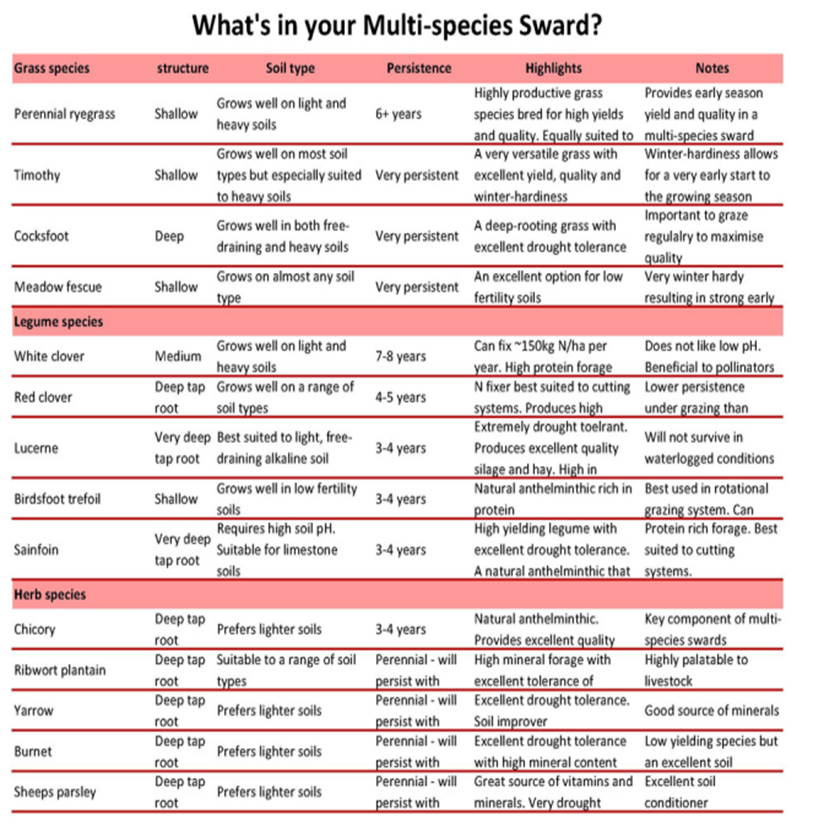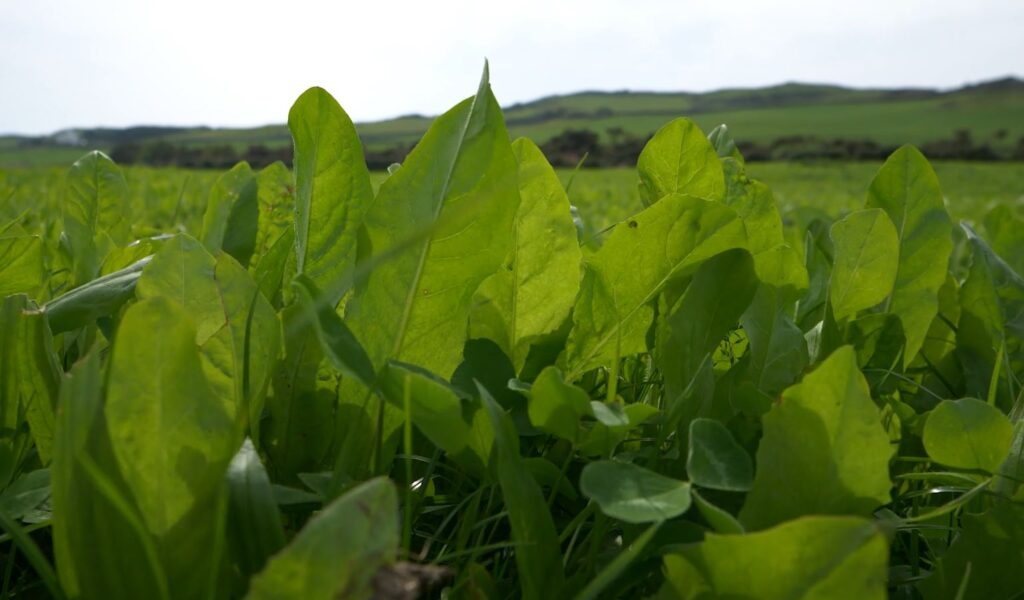Why Grow Multi-Species Swards?
27 March 2024Multi-species swards (MSS) have increased in popularity over recent years, recognised for their ability to produce a similar yield to a perennial ryegrass sward under lower nitrogen inputs, produce higher metabolisable energy and crude protein forage, and their drought tolerance. However, there are some features of these diverse swards which need to be considered as part of the wider farming system to ensure they are managed and utilised correctly.
Multi-species swards are not as persistent as a perennial ryegrass sward and would typically be expected to last only four years. Swards will need rested throughout the winter, dropping a field from winter rotations. Also, due to their different growth habits, MSS need to be managed differently to perennial ryegrass swards to maximise persistence.
An MSS contains three or more different plant species, selected for traits which complement each other for improved productivity when compared to being grown on their own. MSS typically contain grass species, herbs, and legumes.

When considering whether an MSS would fit into your current farming system it is important to evaluate the practicalities and impact. The strengths, weaknesses, opportunities, and threats associated with them are detailed below:

What To Consider When Growing Multi-Species Swards
Site selection
Due to the different growth habits and a sensitivity to poaching, a multi-species sward needs to be managed differently to that of a perennial ryegrass sward, therefore it is important to consider the location for your MSS carefully.
- Fields should be accessible during summer so that stocking densities can be altered frequently depending on the sward growth.
- During winter when the sward needs to be rested consider the impact this will have on forage budgets, field availability and ability to manage other grass swards effectively.
- Multi-species swards need to be rotationally grazed so access to water and electricity for fencing is required.
- What are the characteristics of your site – is it prone to drought or waterlogging? This will dictate what species you sow.
Soil fertility
When sowing any new seed mix, it is critical that soil fertility and soil conditions are suitable for that crop. MSS requires a pH of typically between 6.3 - 6.5, and a moderate status for phosphate and potassium levels, with considerations made as to whether soluble phosphate is required at sowing to aid establishment and development of seedling roots.
If the sward is grazed phosphate and potash offtakes will be limited and similar to that of a grazed grass sward. Offtakes will be greater if the sward is cut and removed. Follow fertiliser recommendations for grass swards using Technical note (TN726): Fertiliser recommendations for Grassland (fas.scot).
Seedbed preparation
MSS can be established in a variety of ways providing there is sufficient soil fertility, temperature and moisture.
- Soil temperature should be slightly higher to that of sowing perennial grass swards, 12 degrees and rising.
- Due to no chemical weed control options the timing of germination of weed species should be considered and the use of a stale seedbed where possible. A stale seedbed would involve preparing the seedbed and then leaving it for 2-3 weeks for weeds to establish. Then spray off with a low rate of glyphosate before drilling the new seed.
- A fine, firm seedbed will ensure good seed-to-soil contact for germination and limit the clods which can harbour weed seeds.
- Due to the variation in seed size, consistency of drilling depth is important. Seed should be drilled no more than 1cm deep or broadcast. Seed could be drilled by direct drilling but ensure the light which penetrates the base of the sward for seedling growth is not limited. The existing canopy can be managed by cutting, grazing or spraying off.
- Seeds should be drilled at 27-32kg/ha (13-15kg/acre).
- To ensure good seed-to-soil contact the seedbed should be rolled post- drilling.
Choosing the right mix
Different species will be suited to different conditions and purposes. When choosing your mixture:
- Identify the conditions your mix will need to withstand and then choose the species which will be best suited to those conditions. Decide how you will use your MSS, i.e. grazing or for silage or both? Different systems will require different management.
- Use some all-rounder species such as perennial ryegrass, white clover and plantain as the basis of your mixture to improve resilience and persistence.
- Observe which species persist in your swards to help inform choices for future mixtures. The use of apps can help you to identify different species and record how the composition of the sward is changing over time, see MULTI-SPECIES SWARD APP – TOMS (multispeciessward.co.uk).
The table below shows some of the most popular species and examples of where they would and would not be suited.

Source - Multi -Species Agronomy Guide 2022 – DLF Seeds & Science
Variations in rooting depth of legumes, herbs and grasses can assist with soil structure by creating gaps in the structure for water and air to move through.

Image source www.cotswoldseeds.com.
Post-establishment management
- A newly sown MSS should be allowed at least eight weeks from sowing until first grazing to ensure that the roots of the species sown can develop fully. Consider the drilling date to ensure there is sufficient time for roots to develop before winter.
- Large applications of nitrogen will have a negative effect on legume persistence, but small applications made in early spring can help to stimulate grass and herb growth before legumes start fixing nitrogen in summer. No more than 90kg N/ha in early spring would be recommended.
Research from University College Dublin and Teagasc has concluded that MSS perform better than a perennial ryegrass sward under zero nitrogen rates and produce comparative yields under varied nitrogen applications. This demonstrates the opportunity multi-species swards present to help reduce reliance on inorganic nitrogen.

- Grazing swards will require a longer rest period than ryegrass swards during summer, typically between 25-30 days rotation. Swards must be rotationally grazed to prevent livestock overgrazing the crown of species such as chicory and red clover. Swards should not be grazed below 6cm.
- If cutting the sward, it should be cut at a height between 6-8cm. It must be cut in dry conditions due to the lower DM content and ideally wilted for 24-48 hours.
- Leave a cover of at least 6cm over winter to prevent stolons from frost damage (this may vary depending on the species within your sward).
- Graze the sward to prevent chicory and plantain flowering as the plant becomes very woody and unpalatable at this stage. These species would be unsuitable to include in a mixture for silage, unless it is cut early before these species become too stemmy. As well as being of lower nutritional value, the more mature the sward is, their fibrous stems can damage and pierce silage bale wrap.
Research work conducted by Germinal Horizon demonstrates the difference in growth patterns between perennial ryegrass swards and MSS mixes depending on the number of species within these mixes. As the graph below shows there is significant variation between the patterns of growth and consequently how these swards would be managed throughout the season, with higher stocking densities required in June on MSS than on ryegrass swards.

Source: Germinal Horizon Spring Ideal for Sowing Multi-Species (germinal.ie)
Are multi-species swards for you?
To maximise the opportunities of multi-species swards increasing the productivity of our livestock enterprises they should be treated like a specialist crop and factored in as part of the wider farming system. Multi-species swards will not fit every farming system or every location, but with careful consideration of where and when they are used and effective management they can improve soil health, increase livestock productivity, and reduce use of inorganic nitrogen, providing an environmental and financial benefit to livestock businesses.
You can find out more about how multi-species swards are being used in a dairy system and for lamb finishing in the videos below.
Sign up to the FAS newsletter
Receive updates on news, events and publications from Scotland’s Farm Advisory Service

